The Samsung 860 PRO (512GB And 4TB) SSD Review: Replacing A Legend
by Billy Tallis on January 23, 2018 10:00 AM ESTRandom Read Performance
Our first test of random read performance uses very short bursts of operations issued one at a time with no queuing. The drives are given enough idle time between bursts to yield an overall duty cycle of 20%, so thermal throttling is impossible. Each burst consists of a total of 32MB of 4kB random reads, from a 16GB span of the disk. The total data read is 1GB.

The 512GB Samsung 860 PRO has the fastest burst random read speed among these SATA SSDs, about 5% faster than the 850 PRO. The 4TB model is the same speed as the 4TB 850 EVO.
Our sustained random read performance is similar to the random read test from our 2015 test suite: queue depths from 1 to 32 are tested, and the average performance and power efficiency across QD1, QD2 and QD4 are reported as the primary scores. Each queue depth is tested for one minute or 32GB of data transferred, whichever is shorter. After each queue depth is tested, the drive is given up to one minute to cool off so that the higher queue depths are unlikely to be affected by accumulated heat build-up. The individual read operations are again 4kB, and cover a 64GB span of the drive.
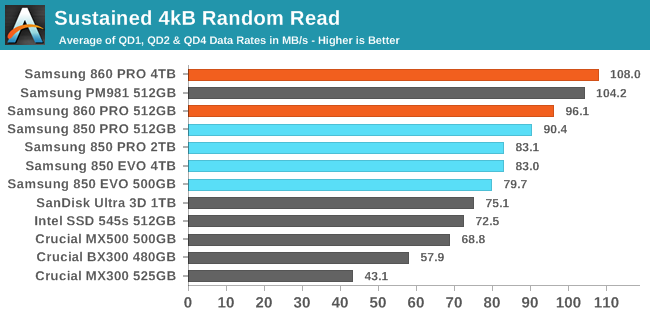
On the longer random read test involving some higher queue depths, the Samsung 860 PROs take a clear lead, and the 4TB model even outperforms the PM981 NVMe SSD.
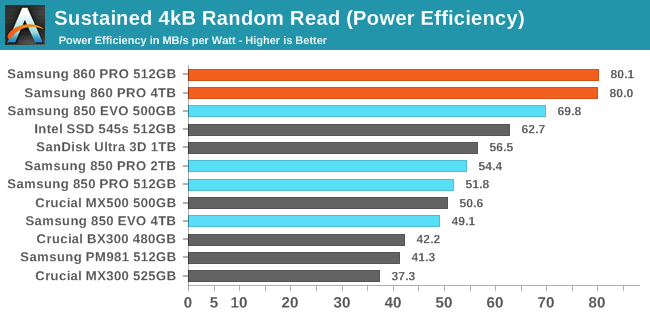
The two Samsung 860 PROs offer the same power efficiency, which is a huge step up from the 850 PRO's efficiency and significantly better than any of the competition.
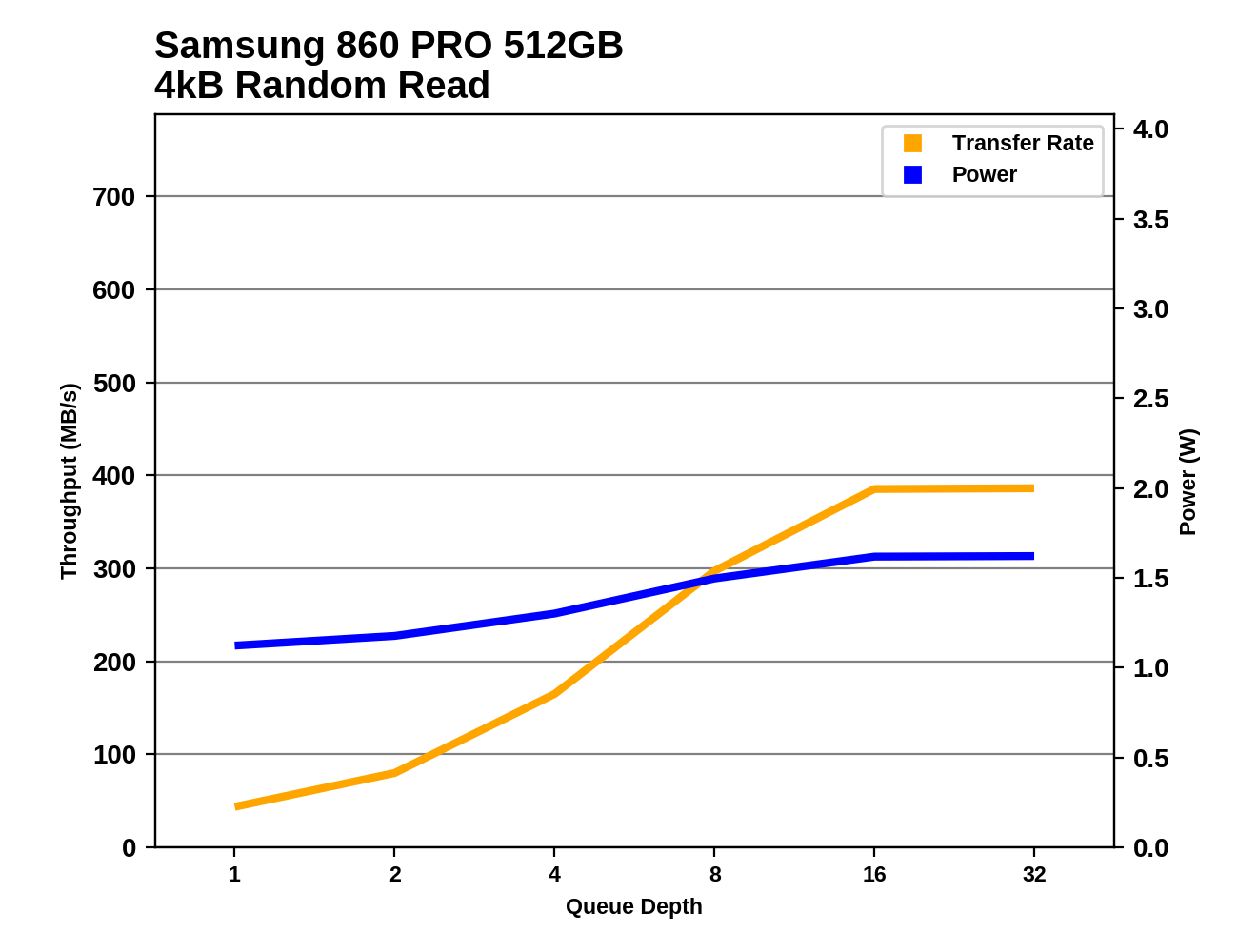 |
|||||||||
Most of the Samsung drives hit the same limit of almost 400 MB/s around QD16. The two latest Crucial SSDs only just reach reach that level of performance at QD32, while the Intel 545s and Crucial MX300 never scale up that far. The PM981 NVMe drive scales far beyond any of the SATA drives, but at the cost of very poor power efficiency, especially at lower queue depths.
Random Write Performance
Our test of random write burst performance is structured similarly to the random read burst test, but each burst is only 4MB and the total test length is 128MB. The 4kB random write operations are distributed over a 16GB span of the drive, and the operations are issued one at a time with no queuing.

The 4TB 860 PRO has the fastest burst random write speed, while the 512GB model scores slightly worse than the 512GB 850 PRO.
As with the sustained random read test, our sustained 4kB random write test runs for up to one minute or 32GB per queue depth, covering a 64GB span of the drive and giving the drive up to 1 minute of idle time between queue depths to allow for write caches to be flushed and for the drive to cool down.
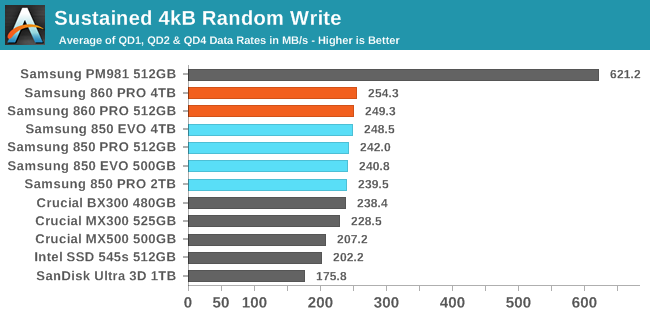
The sustained random write performance of the Samsung 860 PRO is a very slight improvement over their previous drives. Most of the competition is significantly slower on this test, but the Crucial BX300 is pretty close.
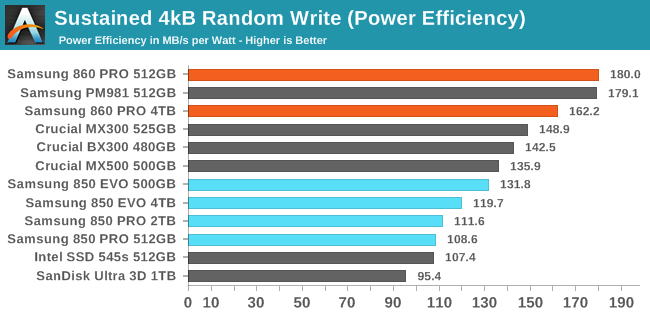
The Samsung 860 PROs are again the two most efficient SATA SSDs, and the 512GB model manages to match the efficiency of the much faster but more power hungry PM981.
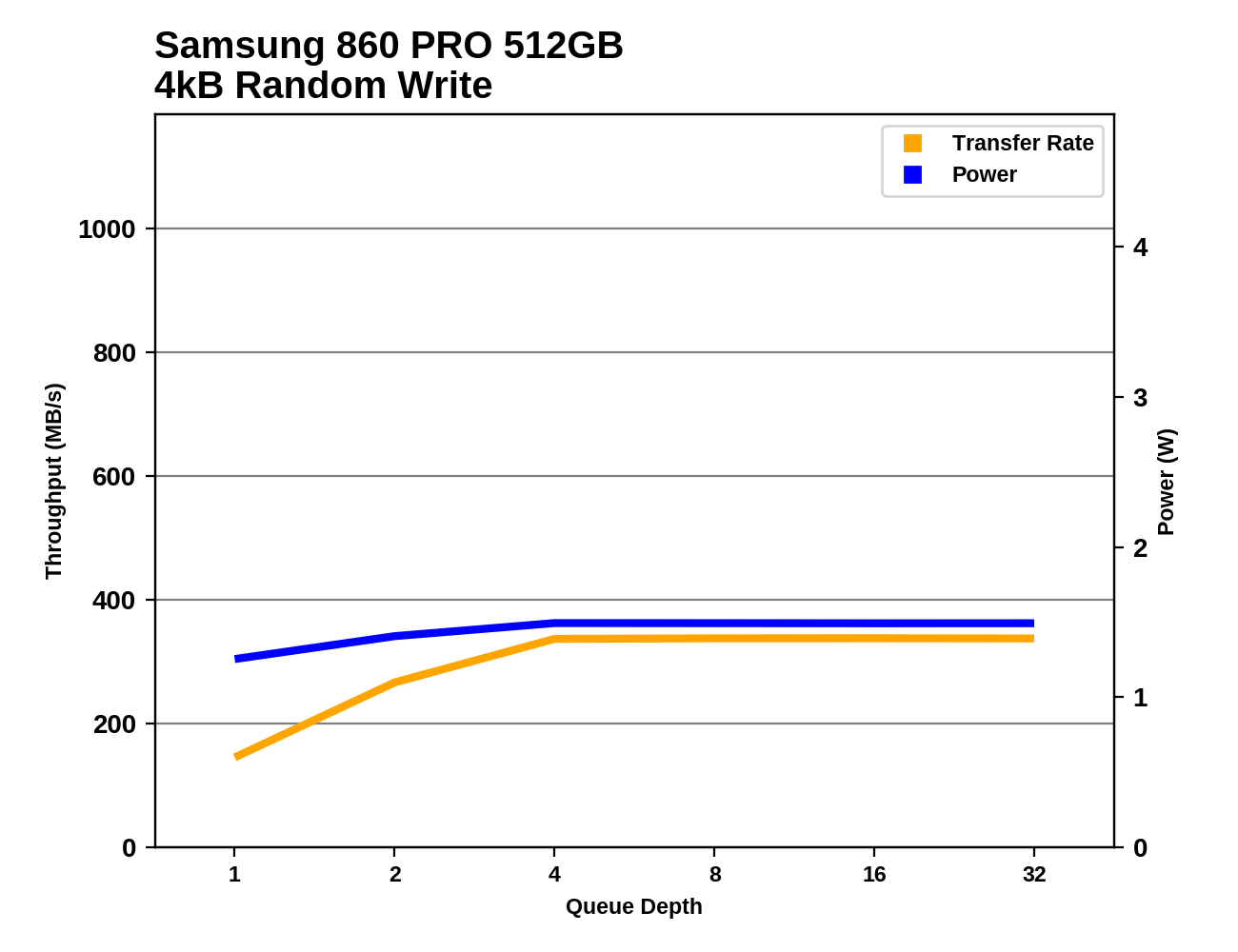 |
|||||||||
The 860 PRO reaches full random write speed at QD4 and is steady through the rest of the test. The Crucial MX500 and Intel 545s are much slower to get up to speed, and the SanDisk Ultra 3D plateaus at a mere 200MB/s after QD2.










64 Comments
View All Comments
WithoutWeakness - Tuesday, January 23, 2018 - link
Impressive drive. We've definitely hit the point where the SATA bottleneck prevents any serious performance improvements. Looks like the 860 EVO nearly matches the PRO's speeds (at least on paper) and costs 33% less at all capacities. It seems like the trend will continue of recommending the latest Samsung EVO drive to anyone who needs a SATA SSD and people with extra money to spend can upgrade to the PRO. Almost no reason to buy any other drives unless you can find them at ridiculous sale prices.generaldwarf - Tuesday, January 23, 2018 - link
the 860 evo is 33% cheaper and 50% less endurant = 860 pro is cheaper on the long runDanNeely - Tuesday, January 23, 2018 - link
Unless you're doing insanely high write levels (for anything in the consumer/prosumer space) both drives will probably fail in 5-10 years of old age without coming anywhere near their endurance limits. The pro just has extra overkill on that number.Flunk - Tuesday, January 23, 2018 - link
Definitely, for client loads you're not going to hit that write endurance before the drive dies from something else.But if the Samsung 860 PRO dies within 10 years it's still under warranty. I recently had a 4.5 year old Samsung 840 PRO die on me and Samsung shipped me an essentially brand new 850 PRO as a replacement. The EVO comes with a 5 year warranty, which while good, is not as good.
DanNeely - Tuesday, January 23, 2018 - link
The 860pro is down to the same 5 years as the 860 EVO.chrcoluk - Friday, September 6, 2019 - link
My 850 pro almost died at 4 years and 10 months (mirroring your view that a 5 year warranty is pushing it close).Sent to samsung RMA, they ran what was clearly a very basic test only (they completed RMA testing in just 40 mins according to status page) and returned as non faulty.
They returned a drive that was randomly not appearing at post and had corrupted boot files as non faulty. I didnt trust it so put it in a spare rig, installed windows on it, and ran some i/o tests, on the first test it locked up during heavy i/o load. After giving it a while to recover I rebooted and the drive was gone in bios, but this time it hasnt recovered at all now seemingly completely dead.
For the curious the erase cycles are extremely low only 40 or so erase cycles, data written was at over 20TB, nowhere near the 150TB warranty.
Given these figures I would say a higher amount of years on the warranty is far more valuable than a higher TBW limit, so the 860 pro's are a nerf. The fact samsung are no longer willing to offer 10 years on their pro units is quite telling. If the 10 year policy wasnt costing them money then they wouldnt mind doing it, which must mean the failure rate at 4+ years is high enough to warrant the change.
Alistair - Tuesday, January 23, 2018 - link
MX500 is cheaper, performs almost the same. And they actually provide warranty service in Canada properly, unlike Samsung.Check this forum:
https://forums.redflagdeals.com/has-anyone-dealt-s...
Samus - Wednesday, January 24, 2018 - link
Yeah, hard to ignore the MX500 and BX300 (if looking for a smaller capacity drive) because they are so easy to find, inexpensive, and the support is solid. I’ve had great luck with crucial/Micron drives, especially models with Marvell controllers, for nearly a decade. I’ll never forget when I installed the C300 in my laptop in 2010, my first experience with 500MB/sec data transfers and 5 second windows startups.Samus - Wednesday, January 24, 2018 - link
The long run of what? By the time the drive warranty is up SATA will go the way of PATA/IDE. Does anybody seriously think SATA will be around in 5 years? We already have consumer hard drives bottlenecked by SATA2!smilingcrow - Wednesday, January 24, 2018 - link
I fully expect SATA3 to be still around in 5 years. Hard Drives and even DVDs aren't going away and it would seem pointless to replace SATA for those types of devices as it offers sufficient bandwidth for years to come.